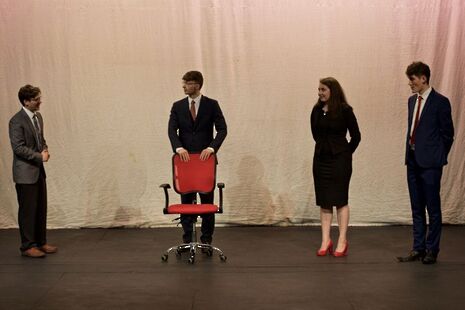Review: BULL
Laura Pujos is captivated by this gripping dissection of workplace politics

The single-word title of Mike Bartlett’s play BULL planted the animal’s image firmly in my mind before the curtain is even up. When the stage is revealed it is starkly bare, Thomas (Adam Mirsky) and Isobel (Megan Gilbert) stand far apart in front of a clinical, white backdrop, under the harsh glare of very bright hanging light fixtures. The spectacle of the bullfight is swapped for office politics, but the empty space, except for a central chair, still manages to evoke something of an arena. Thomas, Isobel, and Tony (Louis Norris) await their boss, Carter (Benedict Flett), who will decide who stays and who goes; three people, two jobs. The play follows this competitive battle between employees when faced with downsizing, or “a cull” as Carter puts it, like you have never seen before.
Gilbert has the teasing cunningness of the matador, bringing to Isobel a sensuous quality as she paces, prowling the stage. Director Daniel Emery has made effective use of repeated movement; she firmly asserts her claim over the space in walking the same path over and over. There are a couple of very effective moments, too, when Isobel is joined by fellow colleague Tony and together they move slowly towards Thomas, blocking him on both sides so he cannot move, entrapping their prey. Gilbert displays a particularly brutal side of the character as she takes a sadistic pleasure in the breaking down of co-worker Thomas piece by piece. Gilbert and Norris together succeed in demonstrating a gradual build-up of the malice directed towards their colleague and it is this slow nature of the action that is so gripping to behold – particularly impressive given the play’s short running time.
By the time the boss, Carter (Benedict Flett) arrives, his blunt way of dealing with Thomas almost provides some relief, because, despite the build up to his arrival and his relative importance, he in fact appears less threatening than his colleagues. The character is, at least, honest with Thomas, whereas the cruelty of Isobel and Tony lies in their, often very humorous attempts to make it seem as if they are doing nothing wrong, for which Norris and Gilbert should be commended for their comic timing. It is all in Thomas’s head, they say; the battle is a psychological one, with their bullying based on a power dynamic wherein they know everything about him, and everything he believes he knows about them could all be a fabrication. The paranoia of not knowing what to believe certainly forms a large part of Thomas’s anguish, handled deftly by Mirsky in his shuffling gait, tense body language and fraught use of gesture. Moreover, he manages to make his movements bull-like, leading with his upper torso and hunched shoulders almost in an animalistic fashion, but without conducting any authority. He is the subject of the cruel sport, not even afforded the respect that the matador has for his opponent.
The energy of the bullfight is translated in the production into strained silences, calculated pacing and rigid stillness. The red muleta of the matador is not entirely lost either, with the flashes of red in the set and costume (the office chair centre stage, Isobel’s shoes, Carter’s socks, and Tony’s tie and lining of his suit jacket) all providing the visual triggers for Thomas to truly ‘see red’. A simple lighting change, bathing the stage in red, at one point is a simple but effective device — it has the potential to be clichéd, but in this case it aptly heightens the drama.
Short and intense, I left very much wondering where I stood, feeling very sorry indeed for Thomas and filled with actual loathing towards Isobel. This was testament to the great talent of all the cast and the whole team behind BULL who made it such a slick production. I recommend ‘taking the bull by the horns’ and seeing this explosive piece.
 News / Fitz students face ‘massive invasion of privacy’ over messy rooms23 April 2024
News / Fitz students face ‘massive invasion of privacy’ over messy rooms23 April 2024 News / Cambridge University disables comments following Passover post backlash 24 April 2024
News / Cambridge University disables comments following Passover post backlash 24 April 2024 Comment / Gown vs town? Local investment plans must remember Cambridge is not just a university24 April 2024
Comment / Gown vs town? Local investment plans must remember Cambridge is not just a university24 April 2024 Comment / Does Lucy Cavendish need a billionaire bailout?22 April 2024
Comment / Does Lucy Cavendish need a billionaire bailout?22 April 2024 Interviews / Gender Agenda on building feminist solidarity in Cambridge24 April 2024
Interviews / Gender Agenda on building feminist solidarity in Cambridge24 April 2024





